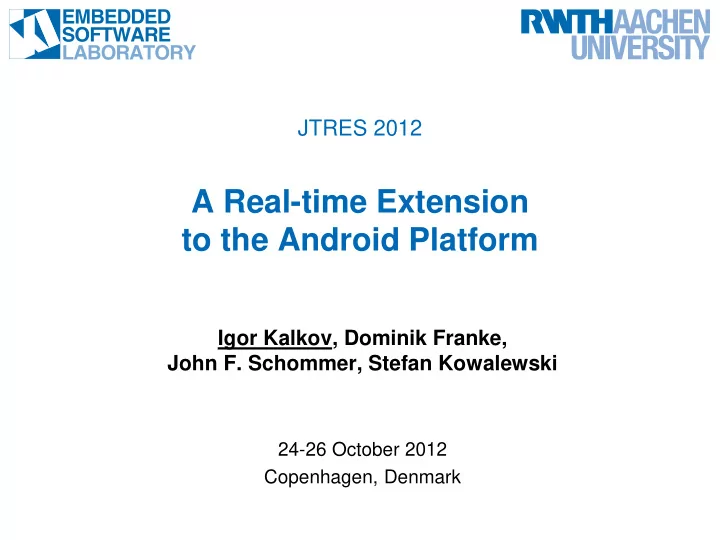

JTRES 2012 A Real-time Extension to the Android Platform Igor Kalkov, Dominik Franke, John F. Schommer, Stefan Kowalewski 24-26 October 2012 Copenhagen, Denmark
Introduction Mobile platform by Open Handset Alliance - Supervised by Google - Open-sourced under Apache 2.0 license Android software stack: Applications Applications • Stock & user applications Application Framework Application framework Runtime • Services & system managers Libraries Android runtime • Dalvik virtual machine Linux Kernel • SSL, media, SQLite database Adapted Linux kernel • Hardware drivers, memory & process management 2 / 15
Motivation Real-time support expands the field of application - Opening safety- & time-critical domains - In-field monitoring, controlling platform for home automation - Better core functionalities: speech or video processing Goals - Possibility of serving real-time requests - Keeping original functionality / backward compatibility Wide range of compatible hardware platforms - Smartphones, tablets, OMAP hardware Further applications: eReaders, TVs, Nanosatellites 3 / 15
Related Work Several proposed approaches: 4 / 15
Approach Applications System Applications 3rd Party Applications Application Framework Extended Activity Manager Notification - Reliable execution of RT apps Activity Manager Package Manager Manager … - Bypassing OOM process killer Resource Manager Window Manager Modified Dalvik VM Libraries Android Runtime - Encapsulated priority selection Graphics SQLite Core Libraries - Explicit memory management … Dalvik Virtual SSL Machine Improved Linux kernel v2.6.29 Linux Kernel - Patched with PREEMPT_RT Power Process Hardware Drivers Management Management - Enabled priority scheduling … Memory Binder (IPC) Driver Management 5 / 15
Activity Manager Internal process importance - Depends on the application class (back- / foreground) - Reflected in OOM adjustment values 𝑏𝑒𝑘 𝑞 Built-in OOM process killer - Killing “unimportant” processes first - Memory thresholds 𝑛𝑓𝑛 𝑢 and corresponding levels 𝑏𝑒𝑘 𝑢 Example with 𝑛𝑓𝑛 3 = 20 𝑁𝐶 and 𝑏𝑒𝑘 3 = 7 - Terminate processes with 𝑏𝑒𝑘 𝑞 ≥ 7 on 𝑛𝑓𝑛 𝑔𝑠𝑓𝑓 ≤ 20 𝑁𝐶 RT processes must get lowest possible 𝑏𝑒𝑘 𝑞 values 6 / 15
Memory Management (1) Advantages: - Smart low memory process killer - Process-independent GC (Dalvik VM) Disadvantages: - Mark-and-sweep algorithm - Execution of all threads is suspended (up to 200 ms) No reliable prediction of process behavior Explicit allocation control 7 / 15
Memory Management (2) 8 / 15
Programming Interface Introducing new class ServiceRT.java - Extends Android’s native Service.java class - API for priority selection for own process - API for explicit memory deallocation Android OS Linux kernel instantiate :ServiceRT set adj_p Normal priority change priority Real-time priority terminate 9 / 15
Evaluation Testing device: HTC Dream / Google G1 Background service based on ServiceRT class Test 1: Periodic execution - Compare scheduled & actual execution time - Period time 𝑢 𝑄 = 1 𝑛𝑡 to 𝑢 𝑄 = 1 𝑡 - Running time 𝑈 = 20 𝑡 to 𝑈 = 1 ℎ - Different process priorities - Idle system or high CPU load 10 / 15
Latencies (1) System state: idle 𝑢 𝑄 = 5 𝑛𝑡 𝑈 = 20 𝑡 Priorities: 120 (default) vs. 40 (real-time) Non-RT Process RT Process 25 25 20 20 Latency (ms) Latency (ms) 15 15 10 10 5 5 0 0 0 5000 10000 15000 20000 0 5000 10000 15000 20000 Execution Time (ms) Execution Time (ms) 11 / 15
Latencies (2) System state: under load 𝑢 𝑄 = 5 𝑛𝑡 𝑈 = 20 𝑡 Priorities: 120 (default) vs. 40 (real-time) Non-RT Process RT Process 2449 7780 1000 10 800 8 Latency (ms) Latency (ms) 600 6 400 4 200 2 0 0 0 5000 10000 15000 20000 0 5000 10000 15000 20000 Execution Time (ms) Execution Time (ms) 12 / 15
Evaluation: Memory Management Automatic GC Manual Freeing Test 2: Continuous data receiving 3000 Memory Footprint (kB) 2900 - Over a 54 Mbit Wi-Fi connection 2800 - Count: 2000 packets 2700 2600 - Size: ~ 1 kB each 2500 - Can be released after processing 2400 2300 2200 0 10 20 30 40 50 60 Time (s) Test 3: Explicit object deallocation Automatic GC Manual Freeing Avg. Freeing Time (ms) 120 - Allocate an object of a given size - Free it immediately 80 - Measure the elapsed time 40 - Calculate average of 10 cycles - For different sizes: 1 Byte to 8 MB 0 0 2000 4000 6000 8000 Object Size (kB) 13 / 15
Conclusion New approach - Patched Linux kernel & Android components - Handling of OOM adjustment values - Use Linux real-time priorities for Android applications - Explicit memory management Evaluation - Avoiding undesired invocations of the GC - Scheduling latency < 2 ms for real-time processes BUT: explicit memory management is not enough - Dangling pointers, background allocations 14 / 15
Future Work Automatic, non-blocking real-time GC algorithms - M. Schoeberl, W. Puffitsch “ Nonblocking Real-Time Garbage Collection ” - Y. Levanoni, E. Petrank “ On-The-Fly Reference-Counting Garbage Collector for Java “ Using RT-Linux high resolution timer for periodic tasks - Better scheduling latencies (WC ≈ 500 us) More about the project will be available soon under https://git.embedded.rwth-aachen.de/rtandroid 15 / 15
Thank you for your attention! Questions / Comments?
Recommend
More recommend